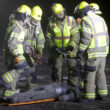By Scott Swanson
Of The New Era
Sweet Home Fire and Ambulance District is taking steps to improve safety for its staff and volunteers, Fire Chief Nick Tyler told members of the Board of Directors at their monthly meeting Tuesday, Oct. 21.
Tyler provided some details of a grant-funded department program that aims to screen firefighters for cancer and other medical conditions related to exposure to hazardous materials while responding to emergencies.
Sweet Home Fire was notified in September that it has been awarded an Assistance to Firefighters Grant award through FEMA.
The $126,857 grant gives the department funding towards a $133,200 project.
The project will provide National Fire Protection Association-compliant physicals and cancer screenings for SHFAD’s 74 firefighters for two years. The project is an effort to identify potentially life-threatening conditions suffered by firefighters to prevent line-of-duty deaths. The goal of the fire district is to establish long-term funding at the completion of the grant, to continue providing these screenings to firefighters.
The purpose of the NFPA physical is to “reduce the likelihood of suffering a preventable
line-of-duty death,” according to a guide on the test provided to firefighters, who are not charged for undergoing the mandatory test. The examination includes vital signs, bloodwork,
urinalysis, spirometry, hearing and vision tests, an ECG/stress test, and examination by a health care provider designated by the fire department.
“This AFG grant was high on my priority list,” Tyler told board members, adding that while “$133,000 doesn’t seem like a lot of money from a grant,” coming up with that money from the department’s budget would be challenging.
“As chief, the minimum thing I can do is protect people from cancers, etc.,” Tyler said.
According to the International Association of Fire Chiefs, nearly half of all firefighter fatalities occur as a result of medical emergencies, due to the “severe physical nature of firefighting” and harsh environmental conditions firefighters face on the job.
“Many of these deaths could potentially be avoided through early detection of underlying medical conditions by participation in an annual routine medical examination, which includes commonplace non-invasive medical testing,” the IAFC stated in an administrative guide it for implementing NFPA 1582, a standard for departments to follow to reduce health risks and improve safety for firefighters.
“The economic costs associated with a firefighter’s death far outstrip the costs of ensuring that firefighters receive an annual medical examination,” the guide says. “Put simply, firefighters lives are worth far more than the cost of implementing a wellness-fitness program that starts with an annual physical.”
Tyler said carcinogen exposure, in particular, is a big risk for firefighters, which is why he wants the department to move quickly.
“These days, when a firefighter develops cancer, we assume it’s from the job. We don’t want to wait until they retire, so we’re establishing a baseline with these physicals, catching things early.”
LifePack Upgrades
Board members unanimously approved spending up to $20,000 to acquire used updated LifePack 15 defibrillators from Portland Fire. Board President Dawn Mitchell was absent from the meeting.
LifePacks are advanced cardiac monitors and defibrillators used by emergency medical personnel to diagnose and treat cardiac emergencies. The devices can record vital signs, monitor cardiac rhythms and deliver defibrillation therapy to restart the heart.
Tyler told them that Battalion Chief Shannon Pettner had found a “good line” on procuring the equipment, which can range in cost from about $20,000 to more than $50,000 each, depending on the model.
The newer models would replace older Model 12’s that are becoming obsolete, Tyler told the board.
“They don’t service Lifepack 12s any more,” he said. “Once the batteries go out, once we have an issue, they’re done.”
Wildland Fire Defense
In other action, the board voted unanimously to accept an $8.7 million Community Wildlife Defense Grant from the U.S. Forest Service, $5.4 million of which is coming directly to SHFAD.
The department was alerted in late September that it had received the grant, which also benefits ODF South Cascade District, Lebanon Fire District, Linn County Juvenile Department, and the South Santiam and Calapooia watershed councils, which have combined to form the Linn Wildlife Mitigation Group. See http://www.sweethomenews.com/sh-fire-gets-8-7-million-grant-for-wildfire-defense.
Tyler said Wildland Supervisor Christian Whitfield with ramrodding the completion of the extensive grant application, with some help from Oregon State University Extension staff, after another partner backed out late in the process.
The grant will pay for personnel over a five-year period: half of Whitfield’s salary, a full-time CWDG coordinator position, six full-time crew members and 10 seasonal crew members, along with equipment that will include power tools and a trailer or truck to haul an excavator with a mastication head, a truck to transport the chipper the department has already purchased, along with office furnishings and a Starlink communication subscription.
It also will fund staffing for some of the other LWMG agencies.
“The biggest single dollar amount is personnel,” Whitfield told the board.
SHFAD will be the umbrella agency, he said. Partner agencies will submit invoices to SHFAD, which will then request the appropriate funding from USFS.
“They go out and do some work, pay employees, and submit an invoice; we are the pass-through agency,” Tyler said, adding that SHFAD’s “next budgetary cycle is going to be interesting, a little more complex.”
The grant will allow partner agencies to work together in a “project pipeline” for more focused and efficient management and collaboration in wildfire defense, accelerate fuels reduction work by increasing fuels mitigation workforce, and education for residents in east Linn County through schools and community outreach, according to the grant application.
Tyler said the effort will include a website with “one-stop answers” for people concerned about wildfire prevention.
Whitifield said the department anticipates being able to apply for future grants to continue the process.
He and Tyler said the department will hire the CWDG coordinator “ASAP” to manage and administer the paperwork and manage the progress reports that will be necessary for the fuels mitigation efforts, as well as helping to organize six community Chipper Days that will be held twice a year at the Cascadia, Crawfordsville and Sweet Home fire stations, and various educational efforts.
In other action, the board:
- Heard from Tyler that the department has changed its information technology services provider from the Oregon West Council of Governments to Fastech Solutions of Vancouver, Wash.
Tyler said the COG has been unable to meet the department’s IT needs in a timely manner and that other departments had recommended Fastech.
“Before we had a contract with them, they came in and fixed my computer in two hours,” he said, adding that COG had been unable to provide the solution. “We had been waiting for six months.
Fastech, he said, sent two technicians down from Vancouver before the district had even signed a contract, who took a look around and then fixed his computer.
- Heard from Battalion Chief Josh Bondessn that the seismic project at Station 23 started Sept. 20 and is “going well” despite a few changes due to “discoveries” made along the way.
Also, Bondesen reported, the department was expecting to get the Engine 21 ladder truck back with repairs to its ladder, damaged in July, by the end of last week.





